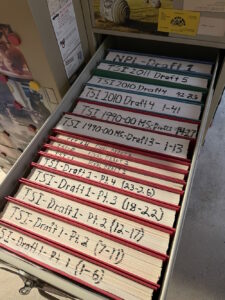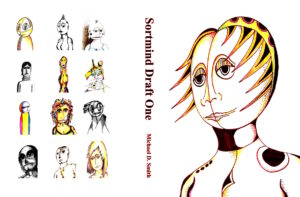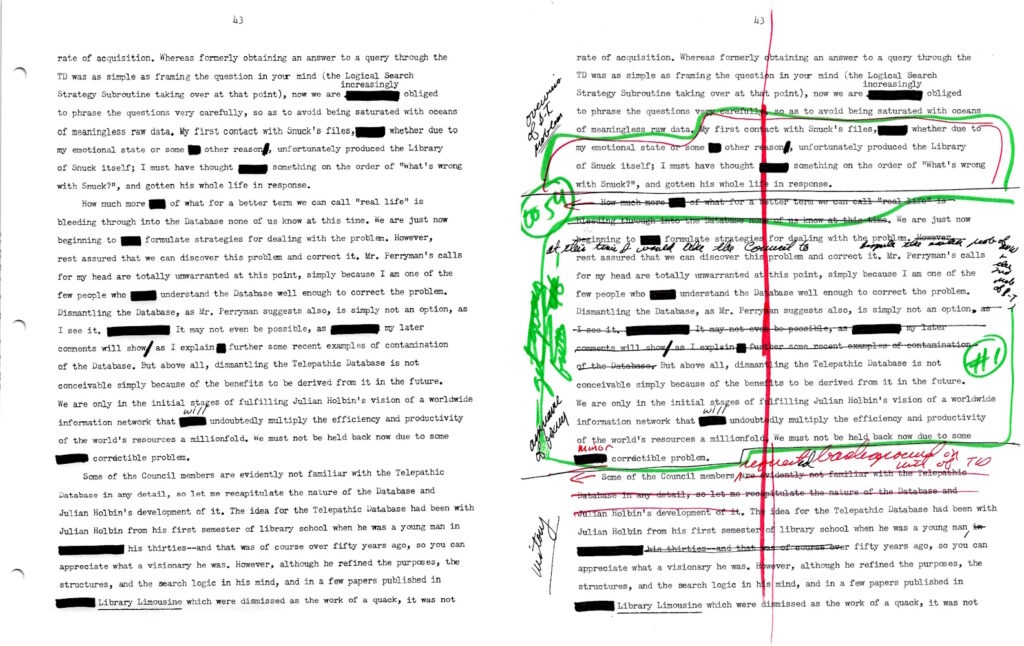The Sortmind Draft One Project
Why
 I sometimes reread first drafts of my novels, usually amazed by how the sprawling but somehow compelling mess eventually congealed into a publishable story–or in some cases, was so bad I abandoned it.
I sometimes reread first drafts of my novels, usually amazed by how the sprawling but somehow compelling mess eventually congealed into a publishable story–or in some cases, was so bad I abandoned it.
When I rediscovered the first draft of Sortmind, 1987-1988, I stumbled into a writing project with unexpected high energy. The rough draft, seen from my current position of not being under any pressure to rewrite it, and not really remembering huge amounts of it, is something I can appreciate as its own finished novel. There are first draft errors, but there’s good writing in this book all the way through, especially considering this is a rough draft.
 I’m finding much of my writing legacy in this draft. If it weren’t for the fact that a better, and much rebooted, final published 2019 version exists, and that the 1987 computerization thoughts would need a lot of reworking, this thing might be cleaned up and presented as a massive Bildungsroman.
I’m finding much of my writing legacy in this draft. If it weren’t for the fact that a better, and much rebooted, final published 2019 version exists, and that the 1987 computerization thoughts would need a lot of reworking, this thing might be cleaned up and presented as a massive Bildungsroman.
How It Came About
In my typewriter days I made photocopies as backups of my novels and so I have a lot of rather useless novel folders now. I figured I could pull some of them from my cramped file cabinets and store them in binders in banker boxes. As I did with other photocopies in the past, I intended to turn some of these into scrap paper. In fact, I assumed I didn’t need an old photocopy of Sortmind’s rough draft and was preparing to turf it as well.
But the photocopy looked pretty clean, and I figured I might want a handy digital copy to reread. Sheet-feeding thirty-some pages at a time, I quickly got the entire 1,075-page manuscript into PDF format. But something compelled me to go beyond that, and I found myself uploading the PDF chunks into Google Docs, which does a great job OCR’ing the text; then I glued it all together.
My instinct to save the photocopy was on target, as I finally discovered that, though it did get a few corrections in pen and obscuring marker, it’s essentially a perfect version of Draft 1, as opposed to the first typewritten version which was thoroughly marked up for Draft Two work. The difference between photocopy (left) and typewritten (right) is telling:
Getting all this formatted into a single Word document was a pain, but Draft One now incorporates the corrections and deletions made during the first draft (3/13/87-9/9/88), as well as those made on both typescript and photocopy through the beginning of Draft 2 on 2/5/89; I’m still astonished that I kept both typescript and photocopy congruent with updates during that time.
Thus Sortmind Draft One is a somewhat polished first draft, not the UR-draft. It obviously won’t be published since the 2019 version of Sortmind is the final one. Draft One’s word count is 401,571; the final’s is 132,854–33.08% of the original.
There are no changes to the original Draft One manuscript except:
- Correcting typos and standardizing capitalization and spelling
- Making formatting changes for clarity
- Adding back a few items (17 total) deleted between September 1988 and February 1989 that struck as being part of Draft’s One’s flavor.
The Vast Differences
Since I dated every writing session, I know that Sortmind’s drafts ran:
- Draft 1, 3/13/87-9/9/88
- Draft 2, 2/5/89-6/21/90
- Draft 3 to 1994 MS., 6/30/90-4/10/94
- Draft 4, 2/13/06-2/15/07
- Draft 5 to 2008 MS. (envisioned as a trilogy), 11/8/07-4/26/08
- Draft 6 (trilogy concept abandoned), 5/17/10
- Draft 7 (major reboot), 4/9/16-8/14/16
- Draft 8, 8/25/17-12/21/17
- Draft 9 to 2019 MS., 12/22/17-2/11/19, then various formats published by 2/14/19
Though the second draft shed much of the first’s meandering storylines, it was faithful to the initial vision, and I sent out numerous publisher queries for the resulting 1994 manuscript. The 2006-2010 versions likewise worked off the original concept as I struggled to get this lengthy book into what I thought was a more publishable shape. But I finally recognized my desperation here as I polluted the style with italicized thinking and tried to market the thing as a trilogy.
By the time I got on top of what I really wanted from this novel, I produced a major 2016-19 reboot which shortened the book, moved the action away from the library world, updated the technology, dramatically altered the plot, removed any consideration of eighties-era architectural considerations in favor of telepathy and alien contact, and centered and developed the characters.
Looking back at the original version, I’m struck by the immense amount of cut storylines, many of which I had forgotten writing. Here are some I dropped along the way. These weren’t just minor character mentions, either; they had themes that went through the book and reappeared at decisive plot points:
- Laura Plaster, the assaulted alien, and Ben Plaster, her malignant stepfather
- Lucinda Zavala Duce, Tree Leopard sorceress, and her alien friend Thalia from Cnzaar
- Michael McNamara, Ufologist; he and Lucinda, long gone by the final version, have rich histories and serve useful purposes.
- Seventeen-year-old Oliver’s award-winning adolescent short story, and his barn suicide attempt
- Terrorist Edward Duce’s song-writing career twenty years previously at Darkforce Theological Seminary
- Blar the hapless victim, Blar the inspirational leader, Blar rescued by aliens and transformed into an eloquent robot to calm a riot
- Future demagogue Randall Perrine, Blar and Laura at the Tollhouse in the madhouse of “New Fascist Australia”
- The Air War and Perrine as a Mindwiped bomber tail gunner in Nightmare Mode
- Mitchell Krazmotik’s extensive Nightmare Mode in the scary slums of East Drulgoorijk, where he has illuminating engagements with Oliver’s sister Elise and the alien Shelley
- Oliver and Suzanne’s thwarted romance in the face of the South Pacific Conference disaster
- Suzanne the librarian-in-training kidnapped by the street person Geniushead
- The library director’s pathetic attempts to salvage a failed love affair via lucid dreaming
- Hostages held by For the Triangles Foundation militia on the freeway overpass
- Barbie the cheerleader/Tree Leopard-sorceress
Draft One doesn’t contain the final version’s psychologically correct endings–Oliver choosing the real Teresa over the computer program Suzanne, and deciding to burn his apartment to wipe out the cesspool Edward Duce, but I can still see that its ending works pretty well. Oddly for one of my rough drafts, despite all the meandering storylines, this novel as a whole is one completed narrative that does hold together.
Originally the Telepathic Database problems were conceived of as worldwide until midway into the first draft, when it became necessary to limit all of the action of the novel to one city. Most of the edits to Draft One had to do with this issue. By the time of the final draft, this was developed as a telepathic app available only in the city of Canterra.
What was oddly prescient about 1987-88 Sortmind Draft One:
- The Telepathic Database scraping content from all over the world
- The Anti-Artificial Intelligence group
- The addictive nature of searching, and potential Mindwipe
- The nature of library databases, indexes, and networks
- The shrill debates between rival left and right political factions, though in this case they fought about triangles on top of buildings.
- Ruminations about library and city politics that would keep unfolding through a few more decades
The Library-Centric Version
The library setting doesn’t bother me as much as it did when I decided to reboot the novel in 2016, but now that I’m retired from the library world, I can accept Draft One’s library emphasis more easily.
By the time of the final Sortmind of 2016-2019, I was eager to dethrone the library from the novel, eliminating all references to my earlier librarian career and replacing the library setting with a business start-up. I thought that writing about libraries demonstrated how much in thrall I’d been to libraries, that “Write what you know” had become cute and self-serving. I still feel there’s truth in that, but now I find myself rather glad to see my 1980s ideas about the library so well-documented. The only problem is that despite all the prescient stuff in there, it’s still 1980s tech and so there’s no way I’d feel comfortable releasing this as a “alternate Sortmind novel,” even if I figured out some way it wouldn’t conflict with the final Sortmind. Yet it’s good to see this original effort as a testament to that other profession.
As for New Fiction …
 Creating this document was an amazing experience despite doubts along the way that I’ve just been locked into past-tripping. But there’s important energy here, and I have no fear of my new fiction voice going away.
Creating this document was an amazing experience despite doubts along the way that I’ve just been locked into past-tripping. But there’s important energy here, and I have no fear of my new fiction voice going away.
I got the final PDF to lulu.com and made a quirky, 775-page “private access” paperback. I came up with a cover that reverberates, especially for a book that won’t be published–note the title on the spine only. I made good use of styles to keep the format adjusted as I got the MS. under the 800-page limit, and I think the final result looks good. I’m sure there are still scores of minor errors throughout this thing, but that’s not a concern.
I’m still amazed that, even as a rough draft with meandering sections that were long ago cut from the final Sortmind, this story holds together so well. It really is one of my foundational documents, like Akard Draft One.
In fact, I’m a little jealous of this amazing rough draft and for a while now I’ve felt the blunt energies for another long novel, despite the frustration of not knowing what it is to be. I think this issue is central to why I choose to go ahead and continue the Sortmind Draft One Project through a mere PDF to a final Word document and to an unpublished paperback.
Copyright 2024 by Michael D. Smith



Pingback:The Major 2024 Book Energies – Sortmind Blog – Michael D. Smith
Pingback:Why New Akard 1979? – Sortmind Blog – Michael D. Smith